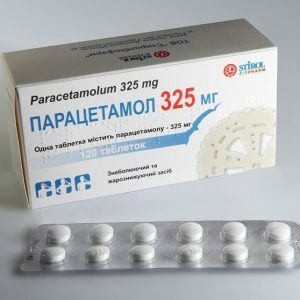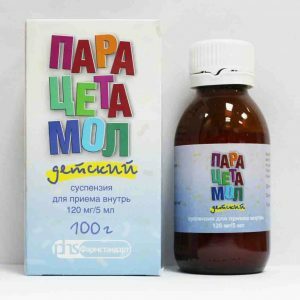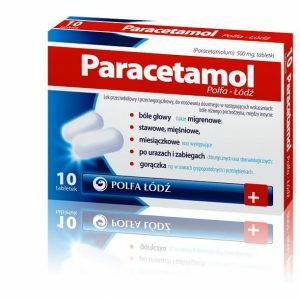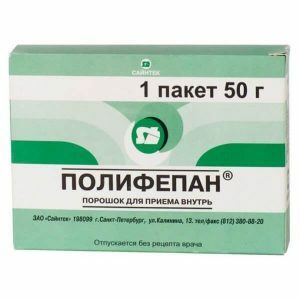Paracetamol: indications, contraindications, side effects

Paracetamol is a common antipyretic and analgesic drug belonging to the group of anilids.In a number of countries, it is available under the name Acetaminophen.The agent does not give the side effects of most NSAIDs, but when taken excessively large doses it can negatively affect the function of the liver, kidneys and circulatory system.
Important: increases the risk of developing side effects( hepato- and nephrotoxic) by concurrent administration of Paracetamol and liquids containing ethanol( including pharmaceutical infusions). In this regard, for the duration of treatment it is recommended to refrain from drinking alcohol.
The undoubted advantage of Paracetamol in front of Acetylsalicylic Acid( Aspirin) is a low risk of exacerbation of chronic gastritis and the development of gastric and duodenal ulcers.
This central non-narcotic analgesic is considered one of the most effective and safe.It is included in the list of "Essentially Essential Drugs", adopted by the Government of the Russian Federation.
Table of contents: Active ingredient and formulations Benefits of Paracetamol Paracetamol: indications for use Method of application and dosage Paracetamol Pharmacological action Pharmacodynamics Paracetamol: contraindications Side effects of Paracetamol What is the risk of overdose of Paracetamol?Interaction with other medicines Paracetamol during pregnancy and lactation Additional informationActive ingredient and formulation
 Active ingredient is para-acetaminophenol( N-( 4-hydroxyphenyl) acetamide).The chemical formula is C8H9NO2.Paracetamol was synthesized in 1877, and clinical trials passed ten years later.Sales of the drug began in 1953 under the trade name Tylenol( USA).In 1956 Panadol appeared on the basis of the same chemical substance.Currently, a huge amount of paracetamol-containing medicines is produced, which additionally includes ingredients such as caffeine, acetylsalicylic acid, codeine, analgin, etc.
Active ingredient is para-acetaminophenol( N-( 4-hydroxyphenyl) acetamide).The chemical formula is C8H9NO2.Paracetamol was synthesized in 1877, and clinical trials passed ten years later.Sales of the drug began in 1953 under the trade name Tylenol( USA).In 1956 Panadol appeared on the basis of the same chemical substance.Currently, a huge amount of paracetamol-containing medicines is produced, which additionally includes ingredients such as caffeine, acetylsalicylic acid, codeine, analgin, etc.
The domestic pharmaceutical companies Paracetamol is produced in usual tablets( 200, 325 and 500 mg), Coated tablets( Panadol Extra by 325 and 500 mg), capsules( 325 and 500 mg each), as well as rectal suppositories( 50, 100, 125, 250 and 500 mg each).
In pharmacy chains sold soluble tablets of 500 mg - Efferalgan, Panadol Extra, Flutabs and Paracetamol-Hemofarm.
Among the popular panadol containing preparations are powders for the preparation of a solution of Fervex and Teraflu.
Injectable form - Perfalgan solution( 10 mg / ml) is also available.For children, you can buy syrups Panadol Baby and Efferalgan Baby, as well as suspensions for oral administration Paracetamol Detsky, Kalpol and Daleron.
Advantages of Paracetamol
 Para-acetaminophenol acts on the thermoregulatory center located in the hypothalamus, so that its antipyretic effect is as close as possible to the process of natural decrease in body temperature.The undoubted advantage of paracetamol before NSAIDs is the selectivity of the effect, which makes it possible to use it for the treatment of children.In addition, the products of the exchange of a drug substance leave the body very quickly, which excludes cumulation( accumulation) in organs and tissues.
Para-acetaminophenol acts on the thermoregulatory center located in the hypothalamus, so that its antipyretic effect is as close as possible to the process of natural decrease in body temperature.The undoubted advantage of paracetamol before NSAIDs is the selectivity of the effect, which makes it possible to use it for the treatment of children.In addition, the products of the exchange of a drug substance leave the body very quickly, which excludes cumulation( accumulation) in organs and tissues.
Paracetamol: indications for use
Paracetamol is a remedy for relieving symptoms.It does not affect the dynamics of the pathological process.The most common indications for the beginning of taking this medicine( HP) are the rise in body temperature( hyperthermia) against the background of catarrhal and viral diseases, as well as pain in the bones and muscles of the flu and other acute respiratory viral infections.
Diseases and pathological conditions in which acetaminophen is recommended:
- headache( including migraine);
- arthralgia( joint pain);
- myalgia( muscle pain);
- neuralgia;
- fever, unspecified genesis;
- sciatica;
- arthrosis;
- toothache;
- algodismenorrhea( painful menstruation).
Method of application and dosage Paracetamol
 Acetaminophen has a therapeutic effect when taking doses of 10-15 mg per 1 kg of body weight.
Acetaminophen has a therapeutic effect when taking doses of 10-15 mg per 1 kg of body weight.
Oral forms of paracetamol( tablets or syrup) are recommended to be taken 1-2 hours after meals, washed down with plenty of liquid( preferably pure water).Admission to a full stomach slows down absorption and, consequently, the development of the expected therapeutic effect.
Paracetamol in the form of suppositories is administered rectally( 1 candle).
The recommended single dose for adults and adolescents over 12 years of age( or body weight of 40 kg) is 1 g( 2 tablespoons by 0.5 grams) and daily dosage is 4 g.
For children under 12 months of age,The dose is determined individually at the rate of 10-15 mg per 1 kg of weight( 60 mg / kg per day).Multiplicity - up to 4 times a day;Between the methods it is advisable to maintain approximately equal time intervals.
For kids from 3 months.Up to 1 year, the dosage is from 24 to 120 mg( up to 4 times a day), and children from 1 to 6 years are given 120-240 mg per reception.
It is undesirable to take Paracetamol for more than 5 consecutive days.If the fever lasts longer than 3 days, and the pain remains more than 5 days, you should consult your doctor .Usually in such cases it is recommended to replace the drug with another analgesic and an antipyretic.To reduce the risk of undesirable consequences, it is advisable to limit the minimum effective doses and adhere strictly to the regimen.
Pharmacological action
 The active substance is able to block the enzyme cyclooxygenase( COX1 and COX2), thereby reducing the level of mediators of pain - prostaglandins.The drug has a direct effect on the centers of thermoregulation and pain, located in the brain.There is reason to believe that the pronounced antipyretic and analgesic effects are caused, among other things, by the selective blockade of COX 3, an enzyme that accelerates the synthesis of prostaglandins and participates in the formation of fever and pain.
The active substance is able to block the enzyme cyclooxygenase( COX1 and COX2), thereby reducing the level of mediators of pain - prostaglandins.The drug has a direct effect on the centers of thermoregulation and pain, located in the brain.There is reason to believe that the pronounced antipyretic and analgesic effects are caused, among other things, by the selective blockade of COX 3, an enzyme that accelerates the synthesis of prostaglandins and participates in the formation of fever and pain.
This drug has relatively weak anti-inflammatory properties, as it is neutralized by peroxidases of peripheral tissues.Paracetamol does not adversely affect water-electrolyte metabolism.
Pharmacodynamics
After oral administration Paracetamol is rapidly absorbed in the digestive tract.The time to reach the maximum concentration in the serum can vary from 30 minutes.Up to 2 hours.About 15% of the active substance is conjugated to plasma proteins.The drug freely passes the blood-brain barrier.Most of the substance undergoes biotransformation in the liver.Half-life time is from 1 to 4 hours( in elderly patients it is somewhat higher).Metabolites( sulfates and glucuronides) and para-acetaminophenol in unchanged form( about 3%) are excreted in the urine.
Paracetamol: contraindications
Contraindications include:
- Individual hypersensitivity( hypersensitivity) to the active substance;
- "aspirin triad"( combination of intolerance to NSAIDs, bronchial asthma and recurrent polyposis of the nose and paranasal sinuses);
- inflammatory diseases, erosion and ulcers of the gastrointestinal tract;
- gastrointestinal bleeding;
- marked functional kidney failure;
- diagnosed hyperkalemia;
- condition after coronary artery bypass graft.
Important: Paracetamol containing preparations are contraindicated in newborns of the first month of life.
Special care should be taken when taking this medication with the following diseases and pathological conditions:
- chronic alcoholism and alcoholic liver damage;
- ischemic heart disease and chronic heart failure;
- cerebrovascular disease;
- affection of peripheral arteries;
- renal and hepatic insufficiency.
Note: in diabetes mellitus is not recommended to take Paracetamol in the form of a syrup.
Side effects of Paracetamol
 Paracetamol intake during pregnancy increases the risk of developing an abnormality such as testicular failure in newborn boys( treatment with cryptorchid often requires surgery).According to a number of researchers, the drug increases the likelihood of developing a bronchial asthma in the child( along with Aspirin).
Paracetamol intake during pregnancy increases the risk of developing an abnormality such as testicular failure in newborn boys( treatment with cryptorchid often requires surgery).According to a number of researchers, the drug increases the likelihood of developing a bronchial asthma in the child( along with Aspirin).
It is also believed that the use of Paracetamol is able to slightly reduce the emotional response of the patient.
Excessive administration of this drug even at therapeutic doses may cause the development of analgesic nephropathy, which results in severe renal failure.
What is the danger of an overdose of Paracetamol?
 Almost any pharmacological preparation in a certain dosage can be deadly.The toxicity of Paracetamol is relatively low, but when it is taken at a single dose in a dose exceeding 10-15 g( for adults) or 140 mg / kg( for a child), serious liver damage develops.This is due to the hepatotoxic effect of the intermediate products of the metabolism of para-acetaminophenol.
Almost any pharmacological preparation in a certain dosage can be deadly.The toxicity of Paracetamol is relatively low, but when it is taken at a single dose in a dose exceeding 10-15 g( for adults) or 140 mg / kg( for a child), serious liver damage develops.This is due to the hepatotoxic effect of the intermediate products of the metabolism of para-acetaminophenol.
Important : death is possible with 40 tablets taken per day.Compliance with the instructions precludes the receipt of a dangerous amount of the drug.
Significant excess of recommended dosages is one of the causes of serious bleeding in the gastrointestinal organs requiring urgent hospitalization.If medical assistance is not timely provided, death is not excluded.
In case of an overdose, hemodialysis is ineffective, and forced diuresis may even be dangerous.When paracetamol is intoxicated, the use of glucocorticoids and antihistamines is unacceptable, as they increase the level of synthesis of metabolic products that have a negative effect on the liver.
Interaction with other medications
It is important to use caution when using Paracetamol in parallel with anticoagulants( Warfarin), antiplatelet agents( including Acetylsalicylic acid), glucocorticosteroid hormones( Prednisolone) and serotonin reuptake inhibitors( Fluoxetine, Sertraline and others.).
Combination with preparations containing phenobarbital( Valocordin, Corvalol) is not allowed.
Paracetamol in pregnancy and lactation
 Paracetamol should not be taken on women during the third trimester of pregnancy.In I and II trimesters, the medicine should be taken as prescribed by the doctor;In this case, the ratio of benefits to the mother and the possible risk to the fetus is taken into account.
Paracetamol should not be taken on women during the third trimester of pregnancy.In I and II trimesters, the medicine should be taken as prescribed by the doctor;In this case, the ratio of benefits to the mother and the possible risk to the fetus is taken into account.
Breast milk penetrates less than 1% of the active substance, so the lactation period is not a contraindication to taking the drug.
Additional information
If the patient's appetite is significantly reduced against the background of the disease, it is recommended to reduce the oral dosage form by half to avoid the risk of irritating the mucous membranes of the digestive tract.
In some preparations, para-acetaminophenol is included in combination with caffeine.It is proved that caffeine enhances the action of Paracetamol by increasing its bioavailability.This combination is very helpful in stopping headaches against a background of low blood pressure.
Amplification of the effect of para-acetaminophenol is achieved with parallel intake of ascorbic acid into the body.Vitamin C slows the excretion of the active substance from the body.
Vladimir Plisov, medical reviewer



